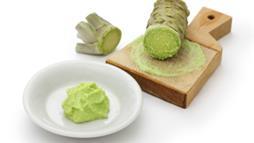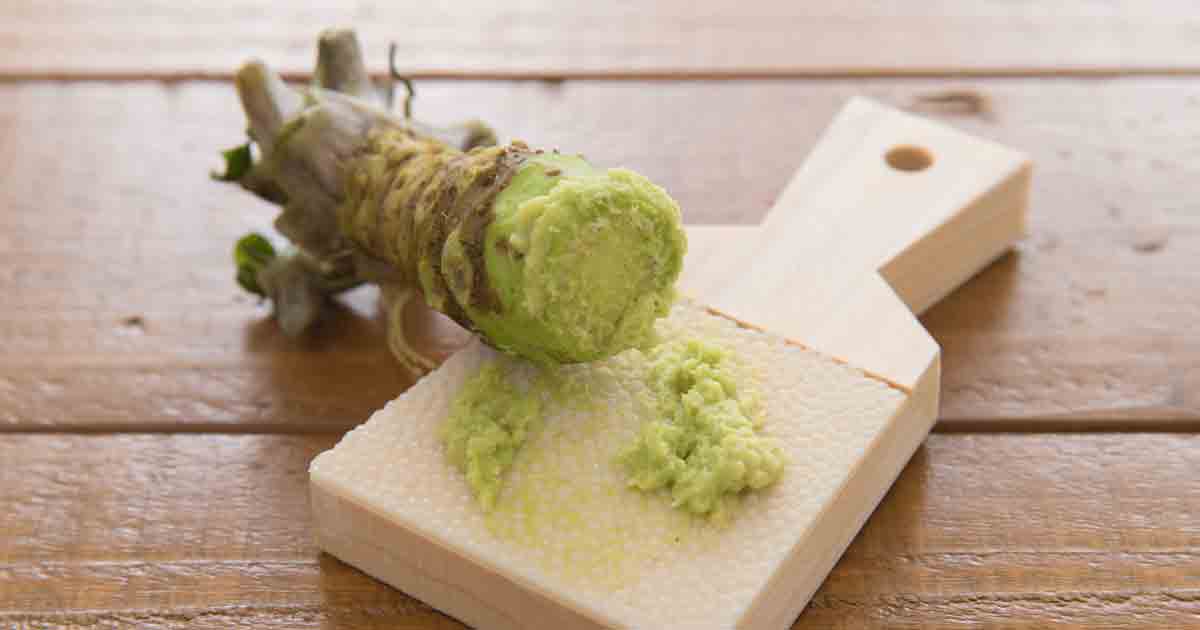The Wasabi You’re Eating May Not Be Real Wasabi

Story at-a-glance
- Wasabi (Wasabia japonica) is a member of the Brassicaceae family, commonly called the mustard family. It is native to Japan, where it thrives in cool mountain streams with lots of shade and running water
- Wasabi is abundant in a unique antioxidant called isothiocyanates that provides a wide array of health benefits, which also happen to be the reason for wasabi’s unique flavor and aroma
Wasabi (Wasabia japonica) is a member of the Brassicaceae family, commonly called the mustard family. It is native to Japan, where it thrives in cool mountain streams with lots of shade and running water. It is prized for its stem which grows to around 2 to 4 inches in diameter and 6 to 12 inches in length, and this is where the actual wasabi condiment comes from.1 Due to its very specific growing conditions, experts consider wasabi to be one of the hardest plants on the planet to cultivate.2
The history of wasabi goes back to prehistoric Japan. There’s archaeological evidence suggesting that during 14,000 B.C. to 400 B.C., the Japanese already utilized wasabi — not for culinary purposes, but for medicinal applications. It is believed that Utogi, a village up north in the Abe River, Shizuoka Prefecture, is the birthplace of wasabi.3
You may have tasted wasabi before, and so may be familiar with its spicy flavor and very strong aroma that you won’t find anywhere else. But chances are that the wasabi you’ve eaten is just an imitation composed of horseradish, mustard powder and food coloring.4
Real wasabi, on the other hand, is still hot and doesn’t leave a burning aftertaste. It’s so fresh that you’ll need to serve it right before eating, because it will lose its iconic flavor within 15 minutes.5 You’ll also be surprised to know that real wasabi contains plenty of nutrients essential for optimal health, such as:6
|
Nutrient |
Unit |
Value (Per 100 Grams |
|
Energy |
kcal |
109 |
|
Protein |
g |
4.8 |
|
Total fat content |
g |
0.63 |
|
Carbohydrate, by differenc |
g |
23.54 |
|
Fiber, total dietary |
g |
7.8 |
|
Calcium |
mg |
128 |
|
Iron |
mg |
1.03 |
|
Magnesium |
mg |
69 |
|
Phosphorus |
mg |
80 |
|
Potassium |
mg |
568 |
|
Sodium |
mg |
17 |
|
Zinc |
mg |
1.62 |
|
Vitamin C |
mg |
41.9 |
|
Vitamin A |
mg |
35 |
Even if It’s Just a Condiment, Wasabi Offers Strong Health Benefits
Wasabi is abundant in a unique antioxidant called isothiocyanates that provides a wide array of health benefits, which also happens to be the reason for wasabi’s unique flavor and aroma. Below are the different health benefits that authentic wasabi can provide you:
• May help lower the risk of cancer — Adding wasabi to your diet may help lower your risk for certain types of cancer thanks to its isothiocyanates. In one study, the 6-MITC [6-(methylsulfinyl)hexyl isothiocyanate] and I7557 [6-methylsulfonyl)hexyl isothiocyanate] compounds in wasabi have been shown to inhibit the growth of pancreatic cancer cells.7
In another study, 6-MITC has been shown to suppress the growth of not only breast cancer, but skin cancer as well.8 Research on this powerful plant is still ongoing, but these findings show great promise already. Remember if you want to reap the benefits of these anticancer antioxidants, use authentic wasabi only, not commercially produced varieties.
• Helps improve cardiovascular health — Wasabi’s isothiocyanates may help prevent platelet aggregation.9 Essentially, platelet aggregation is the clumping together of red blood cells, which can eventually lead to blood clots. These clots are the main sources of stroke and other cardiovascular diseases.10 By adding wasabi to your diet, you may be able to lower your risk of developing these life-threatening conditions.
• Helps fight inflammation — The 6-MSITC in wasabi may help manage inflammation by inhibiting the production of several inflammatory markers, namely cyclooxygenase-2 (COX-2), inducible nitric oxide synthase (iNOS) and cytokines.11
• Fights bacteria throughout your body — Wasabi may be a potent antibacterial agent. In a study published in the International Journal of Food Microbiology, wasabi has been found to be effective against Helicobacter pylori. The roots were found to be the strongest, but the other parts of the plant have been found to help kill the bacteria as well.12
In another study published in the journal Bioscience, Biotechnology and Biochemistry, the stem of the wasabi plant was found to have strong antibacterial properties against E. coli and Staphylococcus aureus. For the methodology, an extract was taken from the roots and placed on the bacteria, which the researchers studied and recorded.13
• Helps improve digestive health — Wasabi contains fiber, which is known to help control your blood sugar by slowing your stomach’s digestion of carbohydrates. Fiber may help you maintain your weight too, as it makes you feel full longer, thereby reducing your cravings for snacks. It’s also good for your intestine, as it may reduce your risk of diverticulitis, an inflammation of polyps in your intestine, by as much as 40 percent.14
It’s Possible to Grow Wasabi in Your Own Home – But It Can Be Challenging
According to Real Wasabi, an American company that specializes in mountain-grown wasabi, certain conditions are required to grow high-quality wasabi:15
“Wasabi prefers cool, shady conditions and will sometimes thrive if left undisturbed in misty mountain stream beds. It generally requires a climate with an air temperature between 8 degrees Celsius (46 degrees Fahrenheit) and 20 degrees Celsius (70 degrees Fahrenheit), and prefers high humidity in summer. Since it is quite intolerant of direct sunlight, wasabi is typically grown under shade cloth or beneath a natural forest canopy.”
Due to the very specific environment needed to grow wasabi, the U.S. has very few locations that can grow wasabi naturally. Only the Pacific Northwest states have been able to successfully cultivate it, namely Oregon, Idaho and Washington, due to their abundance in naturally flowing mountain streams.16 The mountainous regions of North Carolina have been proven to be effective as well.17
Wasabi grows very slowly, and can take up to three years to fully mature. In the right conditions, the long stems (petioles) of the plant should emerge from the (rhizomes) stem, growing around 12 to 18 inches long. Once the plant reaches up to 2 feet in height and width, it enters the next phase where the rhizome produces the nutrients and flavor it is renowned for.
It is possible to grow wasabi on your own if you live near a mountain stream with lots of shade, but keep in mind that the plant could be susceptible to disease and other outside factors that you won’t be able to control.18 You can try growing wasabi in the comfort of your own backyard by using the seedling box method. Here are some useful pointers from a Pacific Northwest Extension publication entitled “Growing Wasabi in the Pacific Northwest,” by Carol Miles and Catherine Chadwick:19
“The seedling box method utilizes planting boxes that are approximately 4 inches deep with bottom drainage holes. A 1.5-inch layer of a well-draining germination or rooting medium such as a vermiculite perlite-peat mix will work as a base. Wasabi seeds should be sown approximately 2 inches apart in the planting box and covered with 0.5 inches of the germination mix (Suzuki, 1968).
An unheated greenhouse is the best place to keep the boxes, which must be watered so the seeds stay moist. However, it is important not to saturate the potting mix. The seeds should germinate in 20 days.”
Wasabi plants are prone to sunburn, so protect them by using a black shade cloth. If you can invest in a small misting or micro-irrigation system, that will help keep the soil moist consistently and make your life easier. The plants require running water, and a micro-immigration system mimics Mother Nature’s running streams. Plant the seeds from September through October so they will germinate before winter begins.20
Selecting the Best Wasabi and Properly Storing It
If you can’t grow your own wasabi, you can purchase from companies that specialize in cultivating certified organic and mountain-grown wasabi. When selecting wasabi, choose the ones that have fresh, unshriveled roots. When looking at wasabi leaves, use the same principle as you would in purchasing salad greens — they must not be soggy and they must have a uniform color.21
To store wasabi properly, wrap the roots in damp towels and refrigerate them when not in use. To maintain the freshness, rinse them in cold water every other day and remove any spoiled roots. If done correctly, your wasabi can last up to 30 days.22
Other Ways to Enjoy Wasabi, Aside From Sushi
For maximum flavor and freshness, wasabi is best prepared right before you serve your meals. To do this, peel the root with a knife, then grate it using circular motions with a metal grater. By grating the wasabi, you’re causing the compounds in the plant to become volatile, thus resulting in the iconic wasabi zing.23 Aside from using it for sushi, you can use grated wasabi in the following ways and with these foods:24
• Add to noodle soups
• A condiment for grilled meats and vegetables
• Add to marinades, dips and salad dressings
• Toss with roasted vegetables
Try This Healthy Wasabi Recipe: Grilled Salmon With Wasabi-Ginger Mayonnaise
This recipe comes from FineCooking.com, but I’ve tweaked some of the ingredients to come up with what I believe is a healthier meal.
Grilled Salmon With Wasabi-Ginger Mayonnaise
Ingredients:
• 1 1/2 limes
• 1/2 cup organic mayonnaise
• 1 1/2 tablespoon wasabi paste (or more, depending on your preference)
• 2 teaspoons finely grated fresh ginger
• 1/4 teaspoon Himalayan salt and freshly ground black pepper
• 4 6-ounce skinless wild Alaskan salmon fillets
• Coconut oil for the grill
Procedure:
1. Prepare a medium-hot grill fire.
2. Cut the half lime into four wedges and set aside. Finely grate the zest from the whole lime. Cut the zested lime in half and squeeze the juice from one half into a small bowl (save the other half for another use). In a medium bowl, combine 1 teaspoon of the lime juice with the lime zest, mayonnaise, wasabi paste, ginger, and 1/4 teaspoon of salt. Stir to combine. Taste and add more wasabi paste if you’d like a zippier flavor.
3. Run your finger along each salmon fillet to feel for tiny bones; use tweezers or needle-nose pliers to pull out any that you find. Season the fillets lightly with salt and pepper. Spoon about 2 tablespoons of the mayonnaise mixture onto the salmon fillets and refrigerate the rest. With your hands, spread the mayonnaise in a thin layer over all sides of the fillets.
4. When the grill is ready, oil the grill grate using tongs and a paper towel dipped in oil. Grill the salmon until crisp for about four minutes. Turn and continue to grill until the salmon is just cooked through for another three to six minutes. Serve the salmon topped with a dollop of mayonnaise and a lime wedge on the side. Pass the remaining mayonnaise at the table.
There’s no doubt that grilling is a big part of U.S. culture, but there’s growing evidence that this method can cause you to ingest cancer-causing chemicals like heterocyclic amines (HCAs), advanced glycation end products (AGEs) and polycyclic aromatic hydrocarbons (PAHs). Following the steps below will help you lower your chances of ingesting these carcinogens that may form during grilling:
• Make sure that you grill the fish under indirect heat so it will not burn right away. I highly recommend using a grilling basket for the fish to flip it easier and prevent it from sticking to the main grill.25
• If any char marks remain, remove them before eating. When cleaning, use a nylon-bristle brush or balls of aluminum foil instead of brush wires, which may stick to your grill and injure your mouth and throat the next time you use your grill.
• Make sure your salmon was caught in the wild, or comes from a reputable organic provider. Wild-caught Alaskan salmon is abundant in omega-3 fatty acids that provide a wide array of health benefits, such as helping fight inflammation. Eating wild-caught fish will also help you avoid ingesting pollutants commonly found in commercially grown fish.
Make Your Own Wasabi Massage Oil to Help Promote Healthy Skin
Aside from just being a popular condiment, you can use wasabi to create your own massage oil that can help improve blood circulation, soothe stiff muscles and make your skin feel alive. Below is the list of ingredients you’ll need:26,27
Wasabi Massage Oil
Ingredients:
Procedure:
1. Combine the coconut and sesame oil in a small pan and place under a very low flame, until it is warm (it’s very important that you do not let the oils reach their smoking point).
2. Turn off the stove immediately and add in the wasabi paste.
3. Cover and let the mixture cool completely.
4. Add the vitamin E oil.
5. Apply to your desired body part and massage.
Note: Do not put the massage oil on cuts, scrapes or burns as the wasabi can sting.
Despite the Promising Benefits of Wasabi, Too Much of It May Not Be Good You
Wasabi is most likely safe to eat. There are no serious side effects reported, but this area still lacks extensive studies, so caution is advised. Those who are allergic to this plant should avoid it to prevent severe reactions. People with blood disorders should exercise care, as wasabi may exacerbate your condition. Pregnant and breastfeeding women should also avoid wasabi, as there’s lack of scientific evidence regarding its safety for this specific group.28
Remember to Use Only Real Wasabi
Again, real wasabi paste is made from the fresh wasabi plant only. The ones that are sold as “wasabi” in supermarkets and restaurants are made of horseradish and artificial flavoring that only mimic real wasabi, so don’t settle for those imitations. Real wasabi is more expensive than imitation wasabi, but I believe that the health benefits it provides are worth the extra cost.
Sources and References
- 1, 19, 20 Washington State University, “Growing Wasabi in the Pacific Northwest”
- 2 BBC, September 18, 2014
- 3 The Tokyo Foundation for Policy Research, “Wasabi”
- 4, 5 Huffington Post, October 12, 2015
- 6 United States Department of Agriculture, 11990, Wasabi, Root, Raw
- 7 Evidence-Based Complementary and Alternative Medicine, “2014;2014:494739”
- 8 Cancer Detection and Prevention, 2005;29(2):155-60
- 9 Biofactors, 2000;13(1-4):271-6
- 10 European Bioinformatics Institute, “Fibrinogen”
- 11 Advances in Pharmacological Sciences, 2012;2012:614046
- 12 International Journal of Food Microbiology, 2004 Aug 1;94(3):255-61
- 13 Bioscience, Biotechnology and Biochemistry, 1998;62(2):363-5
- 14 The Journal of Nutrition, 1998 Apr;128(4):714-9
- 15 Real Wasabi, “Wasabi Is Quite Picky About Its Growing Conditions”
- 16 September 18, 2014
- 17 CNN Money, December 1, 2005
- 18 NC State Extension, “Can I Grow Wasabi in North Carolina?”
- 21, 22, 24 Washington State University, “Wasabi”
- 23 Make Sushi, “Real Wasabi Paste”
- 25 Epicurious, June 14, 2016
- 26 SELF, March 8, 2011
- 27 HowStuffWorks, “Forget About Sush; Rub Wasabi on Your Skin!”
- 28 Natural Standard, “”Natural Standard Herb & Supplement Guide – E-Book: An Evidence-Based Reference”

